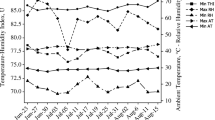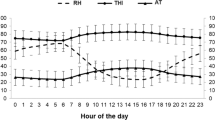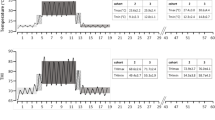Abstract
Holstein cows exposed to simulated summer diurnal ambient temperature cycles of Phoenix, Arizona and Atlanta, Georgia and diurnal modifications of these climates displayed daily cycles fluctuations in plasma thyroxine (T4) and rectal temperatures (Tre). There were daily diurnal changes in T4 and Tre under all simulated climate conditions. Maximal values generally occurred in the evening hours and minimum values in the morning. Although the diurnal rhythm was influenced by the various simulated climates (diurnal modifications) a diurnal rhythm was very evident even under constant conditions at thermoneutral (Tnc) and at cyclic thermoneutral conditions (TN). The major significance of the study is that the initiation of night cooling of the animals at a time when their Tre was highest was most beneficial to maintenance of a TN plasma T4 level. There was a highly significant negative relationship of average T4 and average Tre. There was also a significant negative relationship of feed consumption and average temperature-humidity index (THI).
These data suggest that night cooling may be a most effective method to alleviate thermoregulatory limitations of a hot climate on optimal animal performance. Decreasing the night time air temperature (Ta) or THI or increasing the diurnal range allows the cows to more easily dissipate excess body heat accumulated during the day and minimize the thermal inhibition on feed intake, and alterations in plasma T4 and Tre.
Similar content being viewed by others
Abbreviations
- T4 :
-
Plasma thyroxine, ng/ml
- Ta :
-
Air temperature
- THI:
-
Tdb + 0.36 Tdp + 41.2
- Tre :
-
Rectal temperature, ÐC
- Tymp:
-
Ear tympanic temperature, ÐC
- TN:
-
Thermoneutral cyclic
- TNC:
-
Thermoneutral constant conditions
- ADT:
-
Atlanta diurnal temperature
- ARP:
-
Atlanta reduced peak
- AID:
-
Atlanta increased duration
- AIE:
-
Atlanta increased extent
- PDT:
-
Phoenix diurnal temperature
- PRP:
-
Phoenix reduced peak
- PID:
-
Phoenix increased duration
- PIE:
-
Phoenix increased extent
References
ANDERSON, R. L., and HOUSEMEN, E. E. (1942): Tables of orthogonal polynomial values extended to N = 104. Iowa Agr. Expl. Sta. Res. Bull. 297.
BITMAN, J., TAO, H. and AKERS, R. (1982): Triiodothyronine and thyroxine during gestation in dairy cattle selected for high and low milk production. Fed. Proc. 41: 996. (abstract)
BLINCO, C. R. and BRODY, S. (1955): The influence of diurnally variable temperatures on the thyroid activity and iodide metabolism of Jersey and Holstein cows. Mo. Agr. Exp. Sta. Res. Bull. 579.
CONVEY, E. M., TUCKER, H. A., SMITH, V. G. and ZOLMAN, J. (1973): Bovine prolactin, growth hormone, thyroxine and corticoid response to thyrotropin releasing hormone. Endocrinology 92: 471.
HAYS, F. L., ARMBRUSTER, H., VETTER, W. and BIANCA, W. (1975): Plasma cortisol in cattle, circadian rhythm and exposure to a simulated high altitude of 500 M. Int. J. Biometeor. 19: 127.
HERBERT, V., LAW, K., GOTTLICK, C. W. and BLEICHER, J. J. (1965): Coated charcoal immunoassay of insulin, J. clin. Endocrin. 25: 1375.
JOHNSON, H. D. (1974): Tracer studies in environmental adaptation.In: Tracer Techniques in Tropical Animal Production. International Atomic Energy Agency, Vienna, Pub. No. ST1/PUB 360, pp. 89–100.
JOHNSON, H. D. (1980): Depressed chemical thermogenesis and hormonal functions in heat.In: Environmental Physiology: Aging, Heat and Altitude. Elsevier North Holland, Inc. pages 3–9.
JOHNSON, H. D. and KIBLER, H. H. (1963): Temperature humidity effects on thyroxine I131 disappearance rates in cattle. J. appl. Physiol. 18: 73.
JOHNSON, H. D., RAGSDALE, A. C., YECK, R. G., and JONES, J. J. (1960): The effect of constant environmental temperature 50 or 80 F on the feed and water consumption of Holstein, Brown Swiss and Jersey calves. Mo. Agr. Exp. Sta. Res. Bull. 786.
KIBLER, H. H., BRODY, S. and WORSTELL, D. M. (1949): Influence of temperature, 50 to 105 F, on heat production and cardiorespiratory activities in dairy cattle. Mo. Agr. Exp. Sta. Res. Bull. 435.
LEMARCHAND-BERAUD, T. and VANNATTI, A. (1969): Relationships between blood thyrotropin level, protein bound iodine and free thyroxine concentration in man under normal physiological conditions. Acta Endocrin. 60: 315.
NICOLOFF, J. T., FISHER, D. A. and APPLEMAN, M. D. JR. (1970): The role of glucocorticoids in the regulation of thyroid function on man. J. clin. Invest. 49: 1922.
PREMACHANDRA, B. N. and IBRAHIM, I. I. (1973): Use of thyroxine antibodies for rapid estimation of total thyroxine and free thyroxine index in human sera. Int. Atomic Energy Agency Symp., Greece, 177.
RAY, D. E. and TOUBICEK, C. B. (1971): Behavior of feedlot cattle during two seasons. J. Anim. Sci. 33: 72.
SINGH, D. V., PANDA, J. N., ANDERSON, R. R. and TURNER, C. W. (1967): Diurnal variation of plasma and pituitary thyrotropin (TSH) of rat. Proc. Soc. Exp. Biol. Med. 126: 553.
VANJONACK, W. J., BODE, H. H. and JOHNSON, H. D. (1977): Relationships between milk yield and plasma iodothyronines in Holstein cows. Proceedings of 72nd Annual Meeting of American Dairy Science Association, Iowa State University, Ames.
WIERSMA, F. and STOTT, G. H. (1974): Dairy cow body temperatures in a hot climate. Trans. Am. Soc. Agr. Eng. 17: 745.
WINCHESTER, C. F. and MORRIS, J. J. (1956): Water intake of cattle. J. Anim. Sci. 15: 722.
YOUSEF, M. K. and JOHNSON, H. D. (1966a): Blood thyroxine degradation rate of cattle as influenced by temperature and feed intake. Life Sci. 5: 1349.
YOUSEF, M. K. and JOHNSON, H. D. (1966b): Does a diurnal rhythm of thyroid activity exist in dairy cattle? J. Dairy Sci. 49: 209.
Author information
Authors and Affiliations
Additional information
Contribution from the Missouri Agriculture Experimental Station.
Reference to a company or product name is for specific information only and does not imply approval or recommendation of product by the University of Missouri or the U.S. Department of Agriculture to the exclusion of others that may be suitable.
Rights and permissions
About this article
Cite this article
Scott, I.M., Johnson, H.D. & Hahn, G.L. Effect of programmed diurnal temperature cycles on plasma thyroxine level, body temperature, and feed intake of holstein dairy cows. Int J Biometeorol 27, 47–62 (1983). https://doi.org/10.1007/BF02186300
Received:
Issue Date:
DOI: https://doi.org/10.1007/BF02186300




